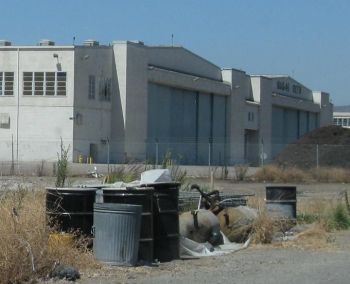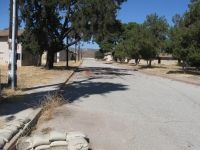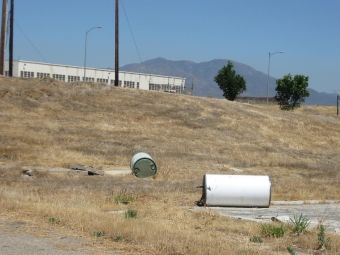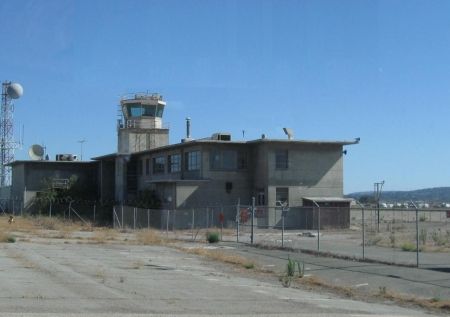
Publisher:
Bonnie King
CONTACT:
Newsroom@Salem-news.com
Advertising:
Adsales@Salem-news.com

~Truth~
~Justice~
~Peace~
TJP
Sep-17-2010 14:18

 TweetFollow @OregonNews
TweetFollow @OregonNews
El Toro Buried Drums of Toxic Chemicals
Robert O'Dowd Salem-News.comInformation was reported to the Navy, who ignored the need to search for the drums.
 The dirtiest part of the old base is the MWSG-37 area; toxins migrated into this part of El Toro for half a century. 2009 Salem-News.com MCAS El Toro photos by Bonnie King |
(IRVINE, Calif.) - El Toro employees buried 55 gallon drums of toxic chemicals to avoid Marine Corps Inspector General inspections and, in the case of half-empty drums, to support the need for ordering full drums of TCE/PCE.
 TCE/PCE was used for decades on the former Marine Corps Air Station El Toro, California. These chemicals were used as degreasers for aircraft parts and for various other purposes. The official Navy/Marine Corps position is that TCE/PCE use was discontinued in the mid-1970's. Reports from Marine veterans dispute this. Marines reported that the chemicals were used on the base in the 1990's. El Toro closed in July 1999.
TCE/PCE was used for decades on the former Marine Corps Air Station El Toro, California. These chemicals were used as degreasers for aircraft parts and for various other purposes. The official Navy/Marine Corps position is that TCE/PCE use was discontinued in the mid-1970's. Reports from Marine veterans dispute this. Marines reported that the chemicals were used on the base in the 1990's. El Toro closed in July 1999.
Information from official government reports show that the chemicals were used even though their authorization was withdrawn and extraordinary methods were taken to hide the evidence from the Marine Corps Inspector General.
Mr. Don Zweifel, Restoration Advisory Board (RAB) member, reported to the Navy during a July 27, 2005 public comments on "El Toro's Draft Record of Decision for Site 24, the Volatile Organic Solvent (VOC) Source Area" that employees told him of the practice of burying drums of contaminants on the base.
No records were maintained of where the barrels were buried and the Navy's official response was no remediation efforts would be undertaken unless the buried barrels were found. Barring a miracle, it's unlikely that the barrels will spontaneously appear on the ground surface. Over time, the steel 55 gallons drums will rot and the toxic contaminants will be released into the soil.


Although this could be a tedious effort, the military has the means of detecting buried metal containers (e.g., land mines). Although not suggested by Mr. Zweifel, a search of the 4,000 acres property by active duty Marine engineers equipped with metal mine detectors could locate the buried drums. Once found, the drums could be removed and properly disposed of.
According to Wikipedia, the simplest form of a metal detector consists of an oscillator producing an alternating current that passes through a coil producing an alternating magnetic field. If a piece of electrically conductive metal is close to the coil, eddy currents will be induced in the metal, and this produces an alternating magnetic field of its own. If another coil is used to measure the magnetic field (acting as a magnetometer), the change in the magnetic field due to the metallic object can be detected."
Why wait for the drums to rot and endanger children and others? A proactive remediation approach would avoid injuries from rotting containers spilling their contents into the ground.
Our review showed that the Navy ignored Zweifel's concerns and the need to find the barrels, citing their policy, "The Department of the Navy (DON) also has a comeback policy that states the circumstances under which the DON will return to perform additional cleanup. One of those circumstances is the subsequent discovery of additional contamination attributable to DON activities. This would allow for additional investigation if buried barrels of contaminants where found anywhere on Former MCAS El Toro property in the future."
The comments from Mr. Zweifel and the Navy's response are as follows:
Mr. Don Zweifel, RAB Member:

"You know, I remember some comments from the employees at MCAS El Toro that told me they buried barrels of contaminants. And why did they do it? I don't know if that's important right now. I can tell you later about why they did it - but actually it had to do with the - if it was a half-filled barrel of PCE, they had to remove that barrel because they wouldn't get a full barrel or - barrels of PCE is vital for cleaning aircraft, they had to have it. The thing is, I'm saying, there are probably barrels buried down here and they are sealed and they are coated, but the thing is, eventually you've got to face it, those barrels are going to leak. They will leak. Maybe they haven't leaked yet, but they eventually will leak."
"Miller Jackson, he was in charge with the physical plant at El Toro years ago, and he said that he knows what they did. When the MG inspection was about to come, they buried - he didn't say where, I don't know if he is alive anymore. I talked to him ten years ago about this. And remember, Andy, I told you about this. And, Content, I already mentioned it to her, most of you guys know. I am just reiterating an old song. The thing is, ladies and gentlemen, this is a great concern to me. What is going to happen to those barrels? Right now it appears everything is okay, but the thing is, I think those barrels will eventually leak."
"I don't know how many of them there are, but I am almost sure there are some barrels there. So what I am proposing, if I may, is that continued monitoring of Site 24 on the periphery, downgradient mind you, for, I don't know, maybe, five, ten, 15, 20 years maybe. Because it will take a while for those barrels to leak, especially if they are coated. And most of the barrels were. And you may say, "Well, how long is it going to take to erode a steel barrel?"
Who knows? It's hard to say. But I'm saying that eventually those barrels will leak. We tentatively or at least potentially think they are there, that's why I'm proposing - I'm sorry, you're going to have to monitor this site for years and years to come to make sure that those barrels, that are probably there, don't leak. And if they do leak, then you're going to have to come back and - see I'm worried about the City of Irvine and Lennar and - because you're going - I mean restrictive covenants on this site, until you can guarantee that.
If you want to sign off on this and say, "There is not going to be any more contamination from this site. You can go ahead. Well, that's great, but your neck should be on the line. And if they find that these barrels have leaked, if they are truly there, well, then you are going to have to come back, the Navy is going to have to come back and solve that problem. And you're going to have to promise that - the Department of the Navy is going to have to promise us that they are not going to leak. And if they do, you are going to have to come back and remediate."
Navy's Response:
"The purpose of this Record of Decision (ROD) is to address vadose soil at Operable Unit 2A Site 24. Extensive investigations, including record searches, employee interviews, and soil and groundwater investigations have been performed at this site. Information obtained during record searches and interviews with Former MCAS El Toro personnel was used as part of the input for the design of sampling programs used during the Phase I and II remedial investigations (RIs) at Site 24. Results from the RIs as well as from subsequent feasibility studies and remedial actions at Site 24 were all approved by the regulatory agencies including the United States Environmental Protection Agency (U.S. EPA), California Department Toxic Substances Control (DTSC), and California Regional Water Quality Control Board (RWQCB) Santa Ana Region. No further action (NFA) is recommended for vadose zone soil at Site 24 and therefore no additional monitoring is recommended in the ROD. It should be noted that there will be additional monitoring at Site 24 related to the groundwater cleanup. Information related to groundwater cleanup at Site 24 is contained within the Sites 18 and 24 ROD. The Department of the Navy (DON) also has a comeback policy that states the circumstances under which the DON will return to perform additional cleanup. One of those circumstances is the subsequent discovery of additional contamination attributable to DON activities. This would allow for additional investigation if buried barrels of contaminants where found anywhere on Former MCAS El Toro property in the future [my emphais]."
Waiting for barrels of toxic chemicals to rot before removing drums does not appear to be a responsible policy, especially when the area may be part of the Great Park, allowing a route of exposure of toxins to children and others using recreational facilities.
=============================================== Bob O’Dowd is a former U.S. Marine with thirty years of experience on the east coast as an auditor, accountant, and financial manager with the Federal government. Half of that time was spent with the Defense Logistics Agency in Philadelphia. Originally from Pennsylvania, he enlisted in the Marine Corps at age 19, served in the 1st, 3rd, and 4th Marine Aircraft Wings in 52 months of active duty in the 1960s. A graduate of Temple University, Bob has been married to Grace for 31 years. He is the father of two adult children and the grandfather of two boys. Bob has a blog site on former MCAS El Toro at mwsg37.com. This subject is where Bob intersected with Salem-News.com. Bob served in the exact same Marine Aviation Squadron that Salem-News founder Tim King served in, twenty years earlier. With their combined on-site knowledge and research ability, Bob and Tim and a handful of other ex-Marines, have put the contamination of MCAS El Toro on the map. The base is highly contaminated with TCE, trichloroethelyne
Bob O’Dowd is a former U.S. Marine with thirty years of experience on the east coast as an auditor, accountant, and financial manager with the Federal government. Half of that time was spent with the Defense Logistics Agency in Philadelphia. Originally from Pennsylvania, he enlisted in the Marine Corps at age 19, served in the 1st, 3rd, and 4th Marine Aircraft Wings in 52 months of active duty in the 1960s. A graduate of Temple University, Bob has been married to Grace for 31 years. He is the father of two adult children and the grandfather of two boys. Bob has a blog site on former MCAS El Toro at mwsg37.com. This subject is where Bob intersected with Salem-News.com. Bob served in the exact same Marine Aviation Squadron that Salem-News founder Tim King served in, twenty years earlier. With their combined on-site knowledge and research ability, Bob and Tim and a handful of other ex-Marines, have put the contamination of MCAS El Toro on the map. The base is highly contaminated with TCE, trichloroethelyne
Articles for September 16, 2010 | Articles for September 17, 2010 | Articles for September 18, 2010

googlec507860f6901db00.html
Salem-News.com:



Terms of Service | Privacy Policy
All comments and messages are approved by people and self promotional links or unacceptable comments are denied.
[Return to Top]
©2025 Salem-News.com. All opinions expressed in this article are those of the author and do not necessarily reflect those of Salem-News.com.